
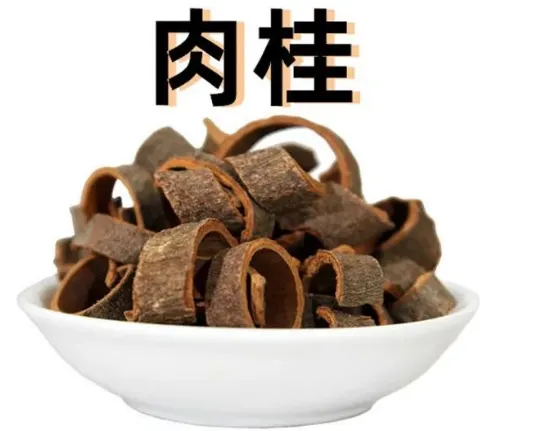
【Name】 Cinnamon
【Pinyin】 Ròu Guì
【Alias】 Mǔ Guì (“Shennong’s Herbal”), Zǐ Guì (“Discussion on Medicinal Properties”), Dà Guì (“Tang Materia Medica”), Là Guì (“Ren Zhai’s Directives”), Guì Pí (“Herbal Compendium”), Yù Guì (“Herbal Origins”).
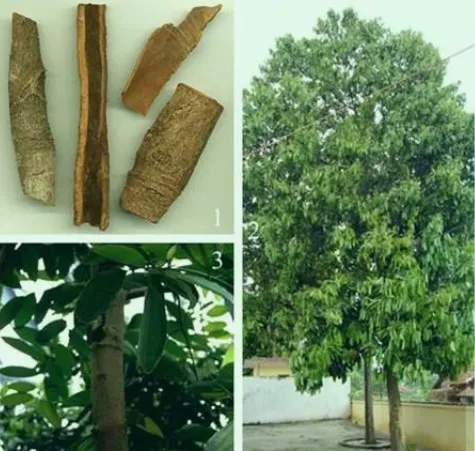
【Source】 The dried bark and branch bark of the Lauraceae plant, Cinnamon. Generally harvested from August to October, the bark is stripped from the tree at a certain width and processed into different specifications, mainly including the following types:
① Guān Guì: The bark of young trees aged 5-6 years is stripped and dried in the shade after being rolled into cylindrical shapes for 1-2 days.
② Qì Biān Guì: The bark of trees over ten years old is stripped, trimmed at both ends, and dried between wooden boards.

③ Bǎn Guì: The bark of older cinnamon trees is stripped at a height of 30 cm from the ground, and the bark is removed and dried until 90% dry, then stacked and pressed for about a month until completely dry. The “Guì Xīn” refers to the strips removed during processing, excluding the cork. All types of cinnamon should be stored in a dry, cool place or in sealed tin boxes.
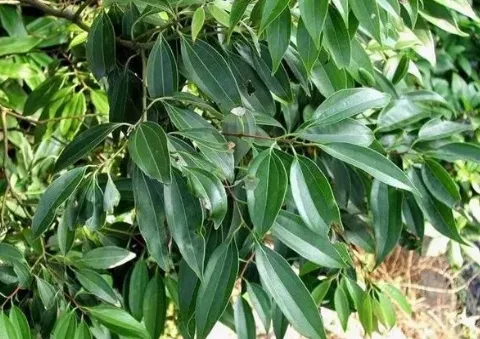
【Morphology】 Cinnamon, also known as Guì Mù (“Classic of Mountains and Seas”), Fén, Mù Guì (“Erya”), Guì Tóng (“Erya” Guo Pu’s notes), Kāng Guì. It is an evergreen tree, 12-17 meters tall. The bark is gray-brown and aromatic, with young branches slightly quadrangular. The leaves are alternate, leathery; elongated oval to nearly lanceolate, 8-17 cm long, 3.5-6 cm wide, pointed at the tip, blunt at the base, entire, green and glossy on top, gray-green underneath with fine soft hairs; with three prominent veins at the base, fine veins parallel; petioles robust, 1-2 cm long. The inflorescence is axillary or near the apex, 10-19 cm long, covered with short soft hairs; flowers are small, about 3 cm in diameter; pedicels are about 5 mm long;
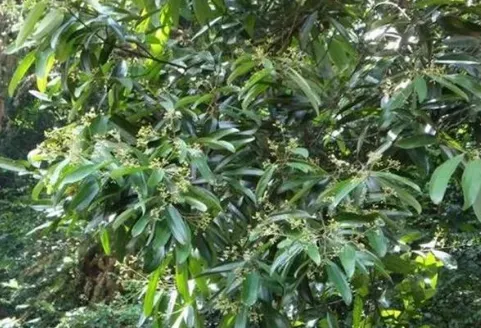
The flower tube is about 2 mm long, with 6 lobes, yellow-green, oval, about 3 mm long, densely covered with short soft hairs inside and outside; there are 9 stamens in 3 whorls, the anthers are oval, 4-celled, lobed, with the outer two whorls of filaments without glands, the inner third whorl of stamens facing outward, with 2 glands at the base of the filaments, and one whorl of degenerate stamens inside, the anthers heart-shaped; the pistil is slightly shorter than the stamens, the ovary is oval, 1-celled, with 1 ovule, the style is slender, nearly equal in length to the ovary, and the stigma is slightly disc-shaped. The fruit is oval or obovate, slightly flattened at the tip, dark purple, about 12-13 mm long, with persistent flower parts. The seeds are long oval and purple. The flowering period is from May to July. The fruiting period is until February to March of the following year. The tender branches (Guì Zhī) and young fruits (Guì Dīng) of this plant are also used medicinally, detailed in specific sections.
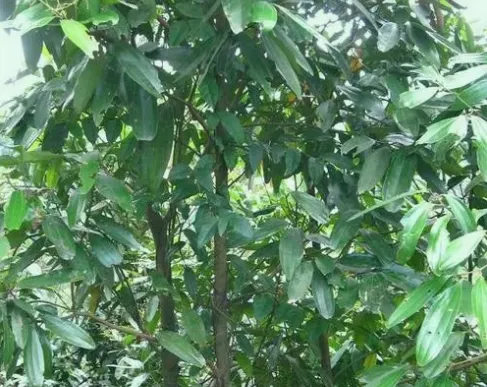
【Distribution】 Cultivated in sandy soil and sloped mountainous areas. Distributed in Fujian, Guangdong, Guangxi, Yunnan, etc. Mainly produced in Guangxi, Guangdong, and Yunnan.
【Properties】 ① Guān Guì (“Herbal Illustrations”) also known as Jūn Guì (“Shennong’s Herbal”), Tǒng Guì (“Tang Materia Medica”), Guì Ér Tōng, Guì Tōng, Tiáo Guì. It is semi-grooved or cylindrical, about 40 cm long, 1.5-3 cm wide, with a thickness of 1-3 mm. The outer surface is gray-brown, with fine wrinkles and small cracks, the pores are oval, occasionally with raised horizontal lines and gray spots; when the cork is scraped off, the surface is smoother, reddish-brown, commonly referred to as “Guì Xīn”. The inner surface is dark red-brown and granular. It is hard and brittle, with a purple-red or brown-red cross-section, showing light-colored stone cell clusters, and the fracture is ring-shaped. It has a fragrant aroma and a sweet-spicy taste.
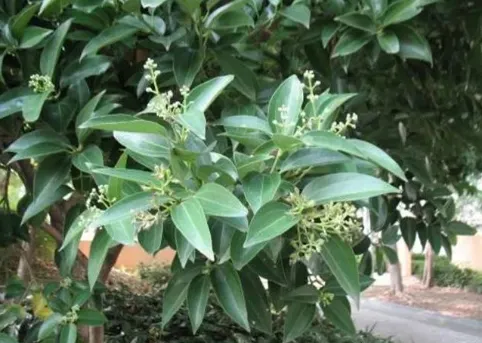
② Qì Biān Guì also known as Qīng Huà Guì. It is long and flat, with both sides curling inward and the center slightly concave, 40-50 cm long, 4.5-6 cm wide, and 3-6 mm thick. The outer surface is gray-brown, and the inner surface is red-brown, showing brown oily patterns when scratched with a fingernail. It has a strong aroma, and other properties are similar to Guān Guì.
③ Bǎn Guì (“Herbal Illustrations”) also known as Guì Nán. It is plate-like, usually 30-40 cm long, 5-12 cm wide, and about 4 mm thick, with rough cut surfaces at both ends. All of the above are preferred for their fine skin and thick flesh, with a purple-red cross-section, high oil content, strong aroma, sweet and slightly spicy taste, and no residue when chewed.
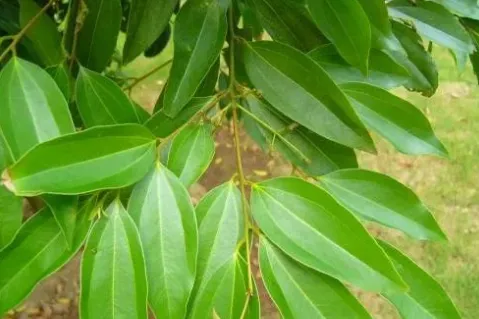
【Toxicity】 Cinnamon is a warm and spicy herb, with “slight toxicity” recorded in the materia medica, and should not be used in excessive amounts. There have been reports of dizziness, blurred vision, eye pressure, dry cough, reduced urination, thirst, and rapid pulse after taking 1.2 taels of cinnamon powder at once, which gradually subsided after taking cooling herbs for 1-2 weeks.
【Preparation】 Remove impurities, scrape off the coarse bark, and crush when needed; or scrape off the coarse bark, soak in warm water for a moment, slice, and dry.
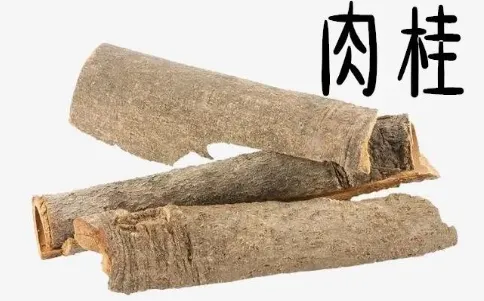
【Flavor and Properties】 Spicy and sweet, hot.
① “Shennong’s Herbal”: “Acrid and warm.”
② “Bielu”: “Sweet and acrid, very hot, with slight toxicity.”
③ “Discussion on Medicinal Properties”: “Bitter and acrid, non-toxic.”
④ “Medical Origins”: “Hot in nature, with a strong acrid taste.”
【Meridians Entered】 Enters the Kidney, Spleen, and Bladder meridians.
① “Pearl Bag”: “Taiyang meridian.” “Foot Shaoyin meridian.”
② “Leigong’s Preparation and Medicinal Properties Explained”: “Enters the Heart, Spleen, Lung, and Kidney meridians.”
③ “Herbal Compendium Explained”: “Enters the Hand and Foot Shaoyin, and Jueyin blood divisions.”
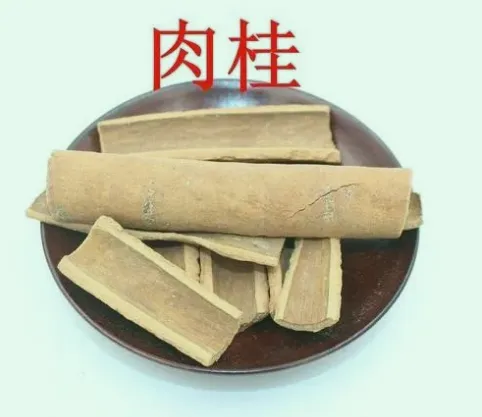
【Effects】 Tonifies Yang, warms the Spleen and Stomach, eliminates cold accumulation, and promotes blood circulation. Treats deficiency of the Mingmen fire, cold limbs with weak pulse, loss of Yang leading to collapse, abdominal pain and diarrhea, cold hernia, cold pain in the waist and knees, menstrual disorders, yin sores, and floating Yang with heat above and cold below.
① “Shennong’s Herbal”: “Mainly treats cough with reversed Qi, throat obstruction, benefits joints, tonifies the middle and boosts Qi.”
② “Bielu”: “Mainly treats heart pain, wind in the flank, flank pain, warms the tendons, promotes circulation, stops restlessness and sweating. “Mainly warms the middle, benefits Liver and Lung Qi, treats cold and heat in the heart and abdomen, cold diseases, cholera, cramps, headaches, waist pain, stops salivation, cough, and nasal congestion; can induce abortion, strengthen bones and joints, promote blood circulation, and alleviate insufficiency; facilitates the action of all medicines, with no fear.”
③ “Discussion on Medicinal Properties”: “Mainly treats various heart pains, kills three worms, breaks blood, promotes menstruation, treats soft feet, numbness, retained placenta, eliminates cough with reversed Qi, obstruction, and cold air in the abdomen, unbearable pain, treats diarrhea, and nasal polyps. Kills plant and wood toxins.”
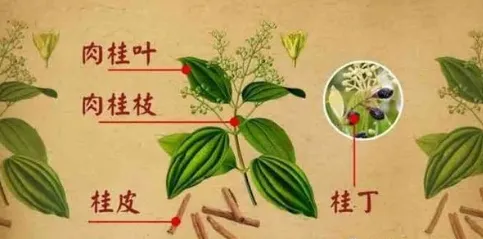
④ “Rihua’s Materia Medica”: “Treats all wind diseases, tonifies the five labors and seven injuries, opens the nine orifices, benefits joints, nourishes essence, brightens the eyes, warms the waist and knees, breaks phlegm and masses, eliminates stasis.”
⑤ “Pearl Bag”: “Removes wind evil, treats abdominal pain in autumn and winter.”
⑥ “Medical Origins”: “Tonifies the lower jiao deficiency, treats cold shoulders and spontaneous sweating.” “Main Treatment Essentials”: “Promotes urination, stops thirst.”
⑦ “Medication Principles”: “Counters cold evil, treats floating Yang.”
⑧ Wang Haogu: “Tonifies the deficiency of the Mingmen, benefits fire and eliminates Yin.”
⑨ “Compendium of Materia Medica”: “Treats cold bi, wind stroke, excessive Yin leading to blood loss, diarrhea, and shock. “Treats Yang deficiency leading to blood loss, internal abscesses, and can draw blood to transform sweat and pus, and detoxify snake venom.” (Effects and Functions of Cinnamon)
【Cautions】 Avoid use in cases of Yin deficiency with excess fire, and pregnant women should use with caution.
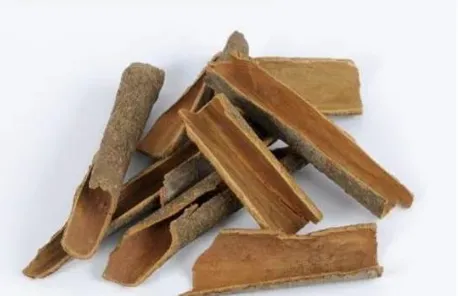
【Additional Formulas】 ① For kidney Qi deficiency, lower jiao cold, abdominal pain, frequent urination at night, weak knees, fatigue, dark complexion, lack of appetite; foot Qi rising, numbness in the lower abdomen; deficiency labor, thirst for water, heavy waist pain, tightness in the lower abdomen, difficulty urinating; male diabetes with frequent urination; female menstrual disorders with difficulty urinating: Mǔ Dān Pí, Bái Fú Líng, Zé Xiè each 3 taels, Shú Dān Huā 8 taels, Shān Zhū Yù, Shān Yào each 4 taels, Fù Zǐ (processed, peeled, and pitted), Ròu Guì (peeled) each 2 taels. Grind into powder, mix with honey to form pills the size of a wutong seed. Take 15-25 pills with warm wine before meals, twice daily. (“Eight Flavor Pill” from “Golden Cabinet Kidney Qi Pill”)
② For insufficient Yuan Yang, declining Mingmen fire, cold Spleen and Stomach, reduced appetite, or nausea and bloating; or stomach upset, or fear of cold, or abdominal pain, or loose stools, frequent diarrhea, or involuntary urination, cold hernia, or cold invading the lower body causing joint pain, or cold in the lower jiao causing water retention, and true Yang deficiency with fatigue, palpitations, and inability to gather energy, Yang decline leading to infertility: Dà Huái Shú Dì 8 taels, Shān Yào (stir-fried) 4 taels, Shān Zhū Yù (slightly stir-fried) 3 taels, Gǒu Qǐ Zǐ (slightly stir-fried) 4 taels, Lù Jiǎo Jiāo (stir-fried pearls) 4 taels, Tù Sī Zǐ (processed) 4 taels, Dù Zhòng (stir-fried with ginger soup) 4 taels, Dāng Guī 3 taels (do not use if loose stools), Ròu Guì 2 taels (can gradually increase to 4 taels), processed Fù Zǐ 2 taels (can gradually increase to 5-6 taels). First, steam the Shú Dì until soft, then pound into a paste, mix with honey to form pills the size of a ball. Chew and take 2-3 pills with warm white soup. (“Complete Book of Jīng Yuè” Right Return Pill)
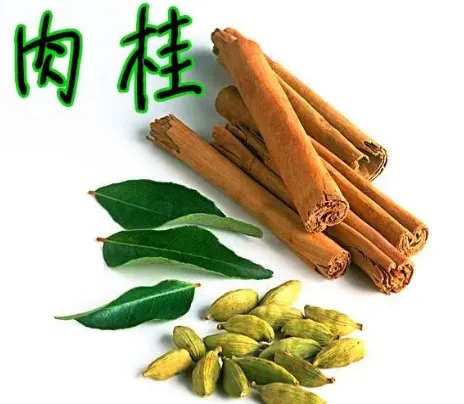
③ For heat stroke and excessive drinking leading to dampness in the Spleen and Stomach, causing disordered digestion: Gān Cǎo (chopped, 1 foot long) 30 jin, Gān Jiāng (processed and stir-fried) 4 jin, Xìng Rén (peeled, pointed, stir-fried) 4 jin 4 taels, Ròu Guì (peeled, roasted) 4 jin. First, stir-fry the licorice until 80% yellow, then add the ginger and stir-fry until the ginger cracks, then add the almonds and stir-fry until the almonds stop making noise, then sift and add the cinnamon, grind into powder. Take 2 qian, decoct until 70% done, remove residue and take warm. If restless, can be adjusted with well water, or taken with boiling water. (“Eight Flavor Powder” from “Jù Fāng”)
④ For cold Qi attacking the heart and abdomen causing pain, nausea, and loss of appetite: Guì Xīn 1 tael, Gāo Liáng Jiāng 1 tael (chopped), Dāng Guī 1 tael (chopped, slightly stir-fried), Cǎo Dòu Kǒu 1.5 taels (peeled), Hòu Pò 2 taels (peeled, coated with ginger juice (stir-fried) until fragrant). Gently crush the ingredients, grind into powder, take 3 qian with water in a medium bowl, decoct until 60% done, remove residue, and take warm without time restriction. (“Shèng Huì Fāng” Guì Xīn Powder)
⑤ For prolonged cold accumulation causing abdominal pain, bloating, diarrhea, and self-sweating: Bì Pí, Ròu Guì each 4 jin, Gān Jiāng (processed), Gāo Liáng Jiāng each 6 jin. Grind into fine powder, boil with flour to form pills the size of a wutong seed. Take 20 pills with rice soup before meals. (“Eight Flavor Cold Pill” from “Jù Fāng”)
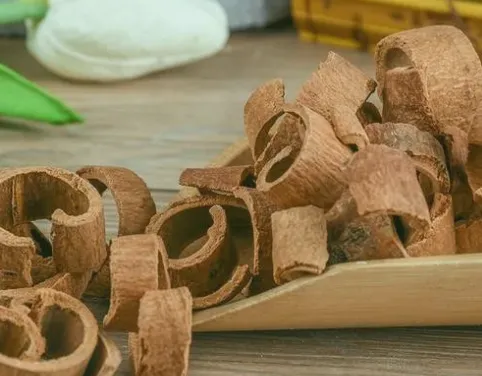
⑥ For nine types of heart pain and obstruction: Guì Xīn half a tael. Grind into powder, take with a cup of wine, decoct until half a cup, remove residue, and take warm. (“Shèng Huì Fāng”)
⑦ For prolonged diarrhea and water retention: Guì (peeled), Fù Zǐ (processed, peeled), Gān Jiāng (processed), Chì Shí Zhī each 1 tael. Grind into powder, mix with honey to form pills the size of a wutong seed. Take 20 pills with rice soup before meals, three times daily. (“Shèn Jì Zǒng Lù” Guì Fù Pill)
⑧ For cold hernia causing abdominal pain: Guì Xīn 4 taels, Shēng Jiāng 3 taels, Wú Zhū Yú 2 taels. Cut into pieces, boil with 1 large sheng of wine until 3 cups remain, remove residue, and take warm in three doses. Avoid raw scallions. (“Yáo Sēng Tǎn’s Collected Proven Formulas” Zhù Xīn Soup)
⑨ For floating hernia and abdominal obstruction: Ròu Guì, Gān Jiāng, Xiǎo Huí Xiāng each 5 qian, Mǔ Dān Pí, Mù Xiāng, Bīng Láng each 2 qian, Gān Cǎo 5 fen; decoct in water. (“Fāng Mài Zhèng Zōng”)
⑩ For true cold waist pain, with tight pulse, blue tongue, contracted scrotum, and shivering: Nèi Guì 3 qian, Fù Zǐ 3-4 qian (use raw Fù Zǐ in emergencies), Dù Zhòng 2 qian, take warm. (“Huì Yuē Yī Jìng” Guì Fù Dù Zhòng Soup)

【Historical Legend】
Cinnamon contains rich nutrients and has strong health benefits, historically used by herbalists to treat diseases. It is said that during the Spring and Autumn period, one of the four great beauties of ancient China, Xī Shī, used cinnamon to cure her throat condition.
It is said that during the time of the four great beauties, Xī Shī, while playing the guqin and singing her self-composed song “Falling Leaves of Wutong”, suddenly felt a sore throat. She used a large amount of heat-clearing and fire-purging herbs, which alleviated her symptoms, but they returned once the herbs were stopped. Later, she consulted another doctor who, seeing her cold limbs, clear urine, and weak pulse, prescribed one pound of cinnamon. The pharmacy owner, knowing a bit about Xī Shī’s condition, couldn’t help but laugh: “A swollen and painful throat is a condition of great heat; how can one consume spicy and warm cinnamon?” Thus, he refused to dispense the medicine, and her attendants had to return empty-handed.
Xī Shī said: “This doctor is highly skilled, so he must not be joking. There is no other way now; I will first try a small amount.” Xī Shī first chewed a small piece of cinnamon, finding it fragrant and sweet. After chewing half a pound, her pain disappeared, and she could eat without issue, much to her delight. The pharmacy owner, upon hearing the news, sought the famous doctor for advice. The doctor replied: “Xī Shī’s ailment is a throat disease caused by deficiency cold Yin fire, which cannot be treated without using fire to return to the source. Cinnamon is used to treat throat abscesses in special cases.”
Content sourced from the internet, with gratitude to the original author!

